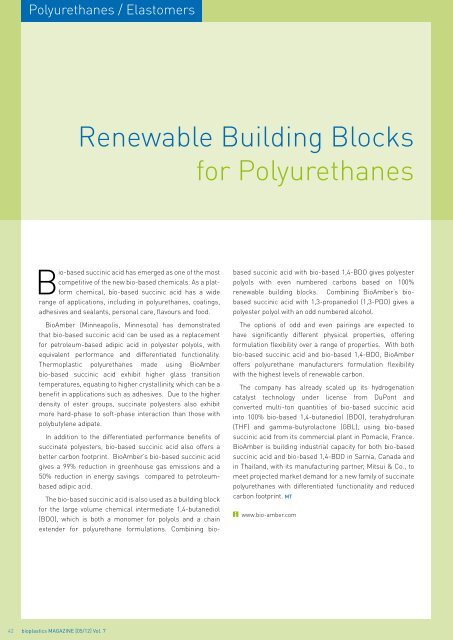bioplasticsMAGAZINE_1205
bioplasticsMAGAZINE_1205
bioplasticsMAGAZINE_1205
You also want an ePaper? Increase the reach of your titles
YUMPU automatically turns print PDFs into web optimized ePapers that Google loves.
Polyurethanes / Elastomers<br />
Renewable Building Blocks<br />
for Polyurethanes<br />
Bio-based succinic acid has emerged as one of the most<br />
competitive of the new bio-based chemicals. As a platform<br />
chemical, bio-based succinic acid has a wide<br />
range of applications, including in polyurethanes, coatings,<br />
adhesives and sealants, personal care, flavours and food.<br />
BioAmber (Minneapolis, Minnesota) has demonstrated<br />
that bio-based succinic acid can be used as a replacement<br />
for petroleum-based adipic acid in polyester polyols, with<br />
equivalent performance and differentiated functionality.<br />
Thermoplastic polyurethanes made using BioAmber<br />
bio-based succinic acid exhibit higher glass transition<br />
temperatures, equating to higher crystallinity, which can be a<br />
benefit in applications such as adhesives. Due to the higher<br />
density of ester groups, succinate polyesters also exhibit<br />
more hard-phase to soft-phase interaction than those with<br />
polybutylene adipate.<br />
In addition to the differentiated performance benefits of<br />
succinate polyesters, bio-based succinic acid also offers a<br />
better carbon footprint. BioAmber’s bio-based succinic acid<br />
gives a 99% reduction in greenhouse gas emissions and a<br />
50% reduction in energy savings compared to petroleumbased<br />
adipic acid.<br />
The bio-based succinic acid is also used as a building block<br />
for the large volume chemical intermediate 1,4-butanediol<br />
(BDO), which is both a monomer for polyols and a chain<br />
extender for polyurethane formulations. Combining biobased<br />
succinic acid with bio-based 1,4-BDO gives polyester<br />
polyols with even numbered carbons based on 100%<br />
renewable building blocks. Combining BioAmber’s biobased<br />
succinic acid with 1,3-propanediol (1,3-PDO) gives a<br />
polyester polyol with an odd numbered alcohol.<br />
The options of odd and even pairings are expected to<br />
have significantly different physical properties, offering<br />
formulation flexibility over a range of properties. With both<br />
bio-based succinic acid and bio-based 1,4-BDO, BioAmber<br />
offers polyurethane manufacturers formulation flexibility<br />
with the highest levels of renewable carbon.<br />
The company has already scaled up its hydrogenation<br />
catalyst technology under license from DuPont and<br />
converted multi-ton quantities of bio-based succinic acid<br />
into 100% bio-based 1,4-butanediol (BDO), terahydrofuran<br />
(THF) and gamma-butyrolactone (GBL), using bio-based<br />
succinic acid from its commercial plant in Pomacle, France.<br />
BioAmber is building industrial capacity for both bio-based<br />
succinic acid and bio-based 1,4-BDO in Sarnia, Canada and<br />
in Thailand, with its manufacturing partner, Mitsui & Co., to<br />
meet projected market demand for a new family of succinate<br />
polyurethanes with differentiated functionality and reduced<br />
carbon footprint. MT<br />
www.bio-amber.com<br />
42 bioplastics MAGAZINE [05/12] Vol. 7


















